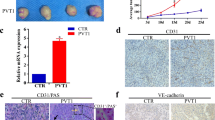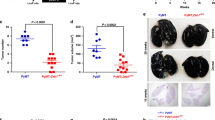Abstract
Purpose
Vascular mimicry (VM) tubules are lumen structures comprised of malignant tumor cells without the participation of endothelial cells. VM simulates blood vessel function in tumors to deliver a sufficient blood supply for proliferation, invasion, and metastasis of malignant tumors, thereby reducing the clinical effects of anti-angiogenic treatments. The elimination or prevention of malignant tumor VM development therefore represents an urgent research goal as a therapeutic strategy to and cut off nutrients required for tumor growth. The GATA transcription factor TRPS1 is abnormally up-regulated in breast cancer, osteosarcoma, prostate cancer, and other tumor tissues, and is instrumental in regulating cell proliferation, differentiation, and tissue growth and development.
Methods
Here, we explored the effects of TRPS1 knockdown on VM and the proteins underlying its development in triple-negative breast cancer cell line MDA-MB-231.
Results
We found that TRPS1 knockdown resulted in obvious inhibition of VM development. Fluorescence microscopy of F-actin and tubulin revealed that loss of TRPS1 function resulted in disruption of cytoskeleton and microtubule formation, respectively. In addition, TRPS1-suppressed cells exhibited reduced accumulation of VM-associated proteins EphA2, MMP-2, MMP-9, VEGF, and VE-cadherin. Moreover, it is interesting to know that the capacity for migration and invasion were limited in MDA-MB-231cells after TRPS1 knockdown and that the average number of VM tubules, their length, and number of intersections were also significantly decreased.
Conclusions
Based on our results, and in light of previous studies, we thus proposed that TRPS1 suppression negatively affects vascular mimicry possibly through reduced TRPS1-mediated transcriptional regulation of VM-related protein VEGF-A.




Similar content being viewed by others
References
Sun HZ, Yao N, Cheng SQ, et al. Cancer stem-like cells directly participate in vasculogenic mimicry channels in triple-negative breast cancer. Cancer Biol Med. 2019;16:299–311.
Zhang X, Zhang J, Zhou H, et al. Molecular mechanisms and anticancer therapeutic strategies in vasculogenic mimicry. J Cancer. 2019;10:6327–40.
Qiao LL, Liang N, Zhang JD, et al. Advanced research on vasculogenic mimicry in cancer. J Cell Mol Med. 2015;19:315–26.
Zhang S, Zhang D, Sun B. Vasculogenic mimicry: current status and future prospects. Cancer Lett. 2007;254:157–64.
Izawa Y, Kashii-Magaribuchi K, Yoshida K, et al. Stem-like human breast cancer cells initiate vasculogenic mimicry on matrigel. Acta Histochem Cytochem. 2018;51:173–83.
Huang D, Lan H, Liu F, et al. Anti-angiogenesis or pro-angiogenesis for cancer treatment: focus on drug distribution. Int J Clin Exp Med. 2015;8:8369–76.
Sun H, Zhang D, Yao Z, et al. Anti-angiogenic treatment promotes triple-negative breast cancer invasion via vasculogenic mimicry. Cancer Biol Ther. 2017;18:205–13.
Bray F, Ferlay J, Soerjomataram I, et al. Global cancer statistics 2018: GLOBOCAN estimates of incidence and mortality worldwide for 36 cancers in 185 countries. CA Cancer J Clin. 2018;68:394–424.
Chen X, Li S, Li D, et al. Ethanol extract of brucea javanica seed inhibit triple-negative breast cancer by restraining autophagy via PI3K/Akt/mTOR pathway. Front Pharmacol. 2020;11:606.
Hong ZP, Hong CY, Ma B, et al. MicroRNA-126-3p inhibits the proliferation, migration, invasion, and angiogenesis of triple-negative breast cancer cells by targeting RGS3. Oncol Rep. 2019;42:1569–79.
Wu Q, Wang J, Liu Y, et al. Epithelial cell adhesion molecule and epithelial-mesenchymal transition are associated with vasculogenic mimicry, poor prognosis, and metastasis of triple negative breast cancer. Int J Clin Exp Pathol. 2019;12:1678–89.
Fujisawa T, Fukao T, Shimomura Y, et al. A novel TRPS1 mutation in a family with tricho-rhino-phalangeal syndrome type 1. J Dermatol. 2014;41:514–7.
Hong J, Sun J, Huang T. Increased expression of TRPS1 affects tumor progression and correlates with patients’ prognosis of colon cancer. Biomed Res Int. 2013;2013:454085.
Li Z, Jia M, Wu X, et al. Overexpression of Trps1 contributes to tumor angiogenesis and poor prognosis of human osteosarcoma. Diagn Pathol. 2015;10:167.
Maes H, Van Eygen S, Krysko DV, et al. BNIP3 supports melanoma cell migration and vasculogenic mimicry by orchestrating the actin cytoskeleton. Cell Death Dis. 2014;5:e1127.
Li FK, Xu JH, Liu SL. Cancer stem cells and neovascularization. Cells. 2021;10:1070.
Hu J, Su P, Jia M, et al. TRPS1 expression promotes angiogenesis and affects VEGFA expression in breast cancer. Exp Biol Med (Maywood). 2014;239:423–9.
Jia M, Hu J, Li WW, et al. Trps1 is associated with the multidrug resistance of osteosarcoma by regulating MDR1 gene expression. FEBS Lett. 2014;588:801–10.
Zhang D, Sun B, Zhao X, et al. Twist1 expression induced by sunitinib accelerates tumor cell vasculogenic mimicry by increasing the population of CD133+ cells in triple-negative breast cancer. Mol Cancer. 2014;13:207.
Maniotis AJ, Folberg R, Hess A, et al. Vascular channel formation by human melanoma cells in vivo and in vitro: vasculogenic mimicry. Am J Pathol. 1999;155:739–52.
Zhou X, Gu R, Han X, et al. Cyclin-dependent kinase 5 controls vasculogenic mimicry formation in non-small cell lung cancer via the FAK-AKT signaling pathway. Biochem Biophys Res Commun. 2017;492:447–52.
Chang GT, Gamble SC, Jhamai M, et al. Proteomic analysis of proteins regulated by TRPS1 transcription factor in DU145 prostate cancer cells. Biochim Biophys Acta. 2007;1774:575–82.
Li X, Sun B, Zhao X, et al. Function of BMP4 in the formation of vasculogenic mimicry in hepatocellular carcinoma. J Cancer. 2020;11:2560–71.
Mitra D, Bhattacharyya S, Alam N, et al. Phosphorylation of EphA2 receptor and vasculogenic mimicry is an indicator of poor prognosis in invasive carcinoma of the breast. Breast Cancer Res Treat. 2020;179:359–70.
Zeng F, Ju RJ, Liu L, et al. Application of functional vincristine plus dasatinib liposomes to deletion of vasculogenic mimicry channels in triple-negative breast cancer. Oncotarget. 2015;6:36625–42.
Chen LX, He YJ, Zhao SZ, et al. Inhibition of tumor growth and vasculogenic mimicry by curcumin through down-regulation of the EphA2/PI3K/MMP pathway in a murine choroidal melanoma model. Cancer Biol Ther. 2011;11:229–35.
Wang S, Zhang Z, Qian W, et al. Angiogenesis and vasculogenic mimicry are inhibited by 8-Br-cAMP through activation of the cAMP/PKA pathway in colorectal cancer. Onco Targets Ther. 2018;11:3765–74.
Wang JY, Sun T, Zhao XL, et al. Functional significance of VEGF-a in human ovarian carcinoma: role in vasculogenic mimicry. Cancer Biol Ther. 2008;7:758–66.
Funding
This study was supported by The National Natural Science Foundation of China (No. 81673908).
Author information
Authors and Affiliations
Contributions
MW conceived and designed the study, and drafted the manuscript. XS and TW collected, analyzed and interpreted the experimental data. MZ and PL revised the manuscript for important intellectual content. All authors read and approved the final manuscript.
Corresponding author
Ethics declarations
Conflict of interest
The authors declare that they have no conflict of interest.
Ethical approval
The study was approved by Ethical Committee of the First Affiliated Hospital of Anhui Medical University and conducted in accordance with the ethical standards.
Informed consent
Subjects signed the informed consent.
Additional information
Publisher's Note
Springer Nature remains neutral with regard to jurisdictional claims in published maps and institutional affiliations.
Supplementary Information
Below is the link to the electronic supplementary material.
Rights and permissions
About this article
Cite this article
Wu, M., Sun, X., Wang, T. et al. TRPS1 knockdown inhibits angiogenic vascular mimicry in human triple negative breast cancer cells. Clin Transl Oncol 24, 145–153 (2022). https://doi.org/10.1007/s12094-021-02676-9
Received:
Accepted:
Published:
Issue Date:
DOI: https://doi.org/10.1007/s12094-021-02676-9




